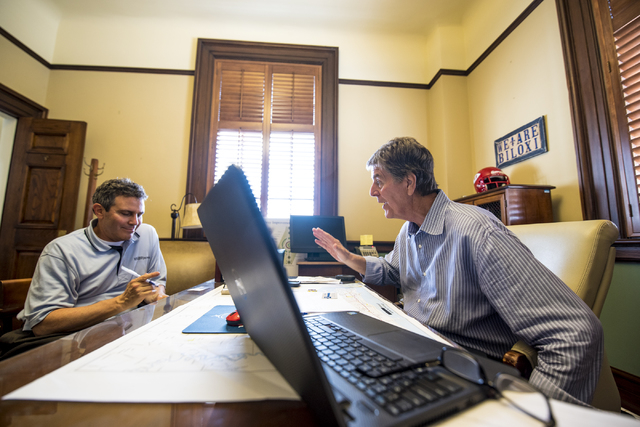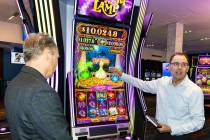Reporter reflects on transformation of gaming over four decades
Glenn Schaeffer, the former chief financial officer of Circus Circus Enterprises, summoned me to the casino operator’s corporate offices one afternoon in late 1990.
The company was preparing to release quarterly financial results.
This was before 2002 passage of the Sarbanes-Oxley Act. Fair disclosure now requires far more financial transparency than a simple press release.
Schaeffer’s request, wanting to discuss the numbers in person, was unorthodox.
I had been following the gaming industry for just a few years, transitioning the coverage from the local pages to the Review-Journal’s business section. At age 31, I welcomed that opportunity.
When I arrived at Schaeffer’s office, however, I found out my interview was actually with CEO William Bennett, the pioneer gaming executive who converted money-losing Circus Circus into a profitable, family-friendly destination resort.
“He wants to talk about the numbers with you,” Schaeffer said.
Bennett, I came to find out, wanted to discuss perception.
Of the two newest resorts on the Strip — Steve Wynn’s $630 million The Mirage and Circus Circus’ $260 million Excalibur — Bennett had the best moneymaker despite Wynn’s claims he owned the Strip’s most profitable resort.
The reality was that Excalibur was larger, had relatively minimal debt and cost one-third of what Wynn spent on The Mirage. It had an easier profitability goal to reach.
I learned a lesson or two about finance. But I also learned about the competition, rivalries and personalities that make up the casino industry. It’s something I’ve come to understand while covering the worldwide growth of legalized gaming over portions of four decades.
Gaming leaders are self-absorbed and temperamental, but they have been visionary in re-creating an industry that was once controlled by America’s organized crime syndicates. Today, it’s influenced by Wall Street, high-finance and Fortune 500 companies.
Gaming is a fascinating industry. I’m honored that I’ve been able to chronicle its journey.
This is my last column for the Las Vegas Review-Journal. On Monday, I will join the Greenberg Traurig law firm as strategic development manager for the Las Vegas office and the firm’s Global Gaming Practice. The communications position allows me to stay involved with the gaming industry.
I moved to Las Vegas in 1982 as a sports writer for the Las Vegas Sun, covering high school sports and UNLV football. In 1984, I wrote about the record-breaking senior year of quarterback Randall Cunningham.
After moving to the education beat at the Sun and to the Review-Journal in 1987, then-city editor Charles Zobell made me the newspaper’s gaming reporter.
I wrote about The Mirage and Excalibur openings, which were the Strip’s first new resorts in 15 years. I’ve covered Las Vegas during the economic upswing, through the recent recession and through the current roller coaster recovery.
In 1989, I wrote about Deadwood, South Dakota, becoming the nation’s third legal casino market, after Nevada and Atlantic City.
Today, casinos, lotteries, and racetracks can be found in every state but two, Utah and Hawaii. Casinos — commercial, Indian, racetrack and riverboat — are in 40 states.
Casino growth in Ohio, Louisiana and Pennsylvania; gaming legislation in Florida; and the booming Indian casino market in California have been subjects of my coverage. I spent time in Atlantic City writing about the troubled Boardwalk gaming market.
I’ve toured Macau, and last year, during a personal vacation, explored casinos in Spain and Portugal. I brought those experiences to Review-Journal readers.
I traveled to the Mississippi Gulf Coast in 2005 to see first-hand how Hurricane Katrina all but wiped out casinos in Biloxi. I went back last August to write about the amazing recovery after 10 years.
In May 2014, I stood on the construction site for MGM Resorts International’s $1.2 billion National Harbor gaming and hospitality resort, which is so close to Capitol Hill, it offers a view of the Washington Monument.
The project illustrates how gaming is entwined in our culture. The American Gaming Association released a study 16 months ago that showed the casino industry contributes $240 billion to the U.S. economy, supports 1.7 million jobs and generates $38 billion in taxes.
The AGA inserted itself into the current presidential campaign, creating the Gaming Votes effort, which ensures the candidates understand the industry’s nationwide economic impact.
The casino business will always have detractors. But it’s an industry constantly changing.
That’s why the largest construction projects in Las Vegas in recent years are nongaming, including The Linq, The Park, T-Mobile Arena and countless hotel room, restaurant, retail, entertainment and nightlife renovations. The casino now accounts for just 35 percent of the Strip’s total annual revenue.
You can find a slot machine or blackjack table almost anywhere in the country. But Iowa, Illinois, Missouri, Colorado and other regional gaming markets can’t replicate Las Vegas.
Bennett, who died in 2002, alluded to this notion when we met 26 years ago. His idea was finding the right niche in Las Vegas. I don’t believe he foresaw the gaming industry expanding as it has, including Indian casinos in his home state of Arizona.
I won’t stop following the gaming industry. I’m just going to work for a different audience.
My journalism career began on the sports pages. Rather than saying I’ve reached the bottom of the ninth or the two-minute warning, my brother Craig suggested a different metaphor. I’ve left my wrestling shoes in the center of the ring.
Find @howardstutz on Twitter.




























